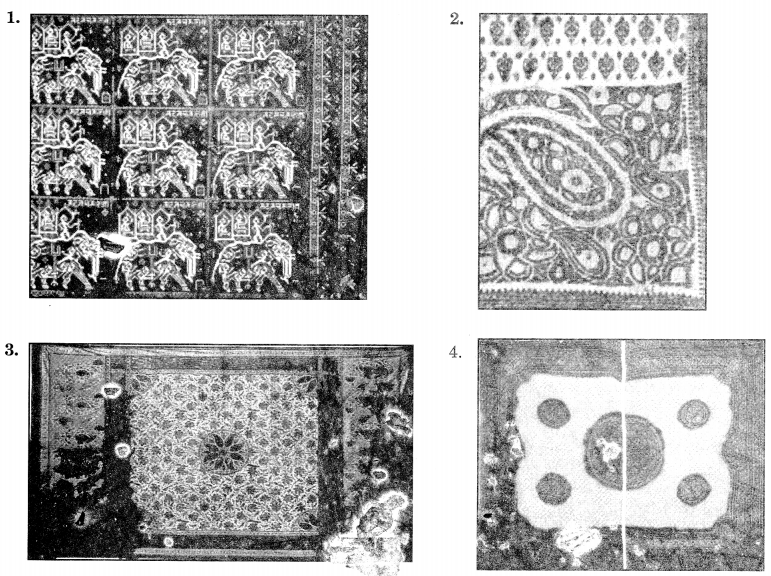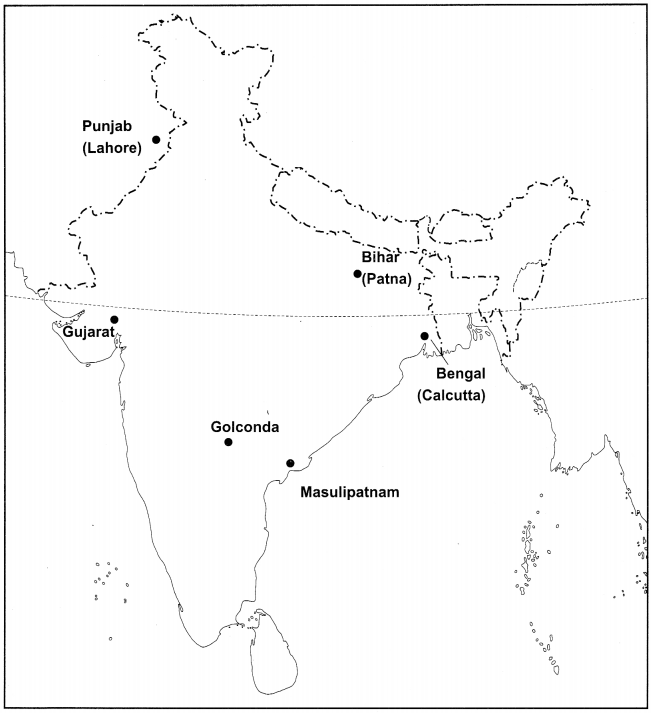Weavers, Iron Smelters and Factory Owners Class 8 Extra Questions and Answers Social Science History Chapter 7 CBSE Pdf free download are part of Extra Questions for Class 8 Social Science. Here we have given NCERT Extra Questions for Class 8 Social Science SST History Chapter 7 Weavers, Iron Smelters and Factory Owners.
You can also practice NCERT Solutions for Class 8 History Chapter 7 Questions and Answers on LearnInsta.com.
Class 8 History Chapter 7 Extra Questions and Answers Weavers, Iron Smelters and Factory Owners
Weavers, Iron Smelters and Factory Owners Class 8 Extra Questions and Answer History Chapter 7 Very Short Answers Type
Question 1.
What made Britain the foremost industrial nation in the 19th century?
Answer:
Mechanised production of cotton made Britain the foremost industrial nation in the 19th century.
Question 2.
Name the place where the Indian textiles were extensively traded.
Answer:
These were traded in Southeast Asia (Java, Sumatra and Penang) and West and Central Asia.
Question 3.
What is meant by Muslin?
Answer:
Finely woven textiles were known as Muslin named by the European traders.
Question 4.
What actually do the term Chintz describe about?
Answer:
Chintz were the printed clothes and the word was derived from Hindi word. Chhint meaning cloth with small and colourful flowery design.
Question 5.
What did the word Bandanna refer to?
Answer:
The word Bandana referred to any coloured and printed scarf for the neck or head.
Question 6.
Which act was passed by the British government banning use of cotton textiles – Chintz in England?
Answer:
The Act was known as the Calico Act.
Question 7.
Who invented the steam engine?
Answer:
The steam engine was invented by Richard Arkwright.
Question 8.
Where did the Tanti weavers belong from?
Answer:
They belonged from Bengal.
Question 9.
What is meant by bellows?
Answer:
Bellows is a device or equipment that can pump air.
Question 10.
Who were the two persons in the year 1904 travelling to search iron ore deposits and in at which place?
Answer:
In 1904, Charles Weld, an American geologist and Dorabji Tata, the eldest son of Jamsetji Tata, were travelling in Chhattisgarh in search of iron ore.
Question 11.
In which year did the TISCO begun producing steel and also name the river bank on which it was situated?
Answer:
TISCO begun producing steel in year 1912 and it was situated on the Subarnarekha River bank.
Question 12.
What does the term smelting mean?
Answer:
The term smelting is the process of obtaining a metal from rock (or soil) by heating it to a very high temperature or of melting objects made from metal in order to use the metal to make something new.
Question 13.
Which were the two industries focused by the British rule?
Answer:
Textile, Iron and Steel industries.
Question 14.
Name the country which was foremost industrial nation in the 19th century?
Answer:
Britain.
Question 15.
Name the country known as the workshop of the world.
Answer:
Britain.
Question 16.
Where is the Surat located in India?
Answer:
It is located in Gujarat.
Question 17.
Name different variety of clothes.
Answer:
- Chintz
- Cossae (Khassa)
- Bandara
Question 18.
In which clothes was the small and colourful flowers were designed?
Answer:
In Chintz
Question 19.
India was the world’s largest producer of which products?
Answer:
Fine quality of cotton textiles.
Question 20.
In which year the Calico act was passed?
Answer:
In 1720.
Weavers, Iron Smelters and Factory Owners Class 8 Extra Questions and Answer History Chapter 7 Short Answers Type
Question 1.
Who was the discoverer of electricity and electromagnetism and what fascinated him the most among Indian products?
Answer:
Michael Faraday, a European scientist was discoverer of electricity and electromagnetism and he was fascinated with the Indian Wootz. He was fascinated in such a way that he spent his four years studying the properties of Indian Wootz.
Question 2.
How was the TISCO set up at an opportune time? Explain in brief.
Answer:
TISCO was set up at an opportune time as in 19th century. India was importing steel that was manufactured in Britain and expansion of Railway in India had provided a huge market for rails that the British produced. Therefore, in such condition sudden decline in the availability of steel during Ist world war made TISCO the biggest steel industry within the British empire.
Question 3.
Mention the reasons behind the Industries conquest and colocalization of India by the British?
Answer:
The reasons were:
- In late 18th-century company was buying raw material from India at cheaper rates and selling than at huge profits in Europe.
- India was seen as the vast market with the growing industrialisation.
Question 4.
What was the process of cloth making?
Answer:
The process involves:
- First stage of production was spinning.
- After the spinning took place threads were woven into cloth by the weaver.
Question 5.
Describe the growth of cotton mills in India.
Answer:
The Ist cotton mill of India was set up in Bombay in 1854, By 1900, over 84 mills started operation in Bombay. Ist mill in Ahmedabad was started in 1861. A year later mill was established in Kanpur.
Question 6.
Name the part of country of the following weaver communities belongs to:
- The Tunti weavers
- The Julahas
- Sale.
Answer:
- Tunti weavers they belong Bengal.
- The Julahas were from North India.
- Sale were from South India.
Weavers, Iron Smelters and Factory Owners Class 8 Extra Questions and Answer History Chapter 7 Long Answers Type
Question 1.
How did Indian Wootz find its place in the history of Tipu Sultan, and what was the actual special feature of Indian Wootz?
Answer:
Tipu Sultan who ruled Mysore till 1799 fought 4 wars with the British and died fighting with his sword which was incredibly hard and sharp-edged that could easily rip through the opponent’s armour.
This quality of sword came from a special type of high carbon steel called Wootz.
Its special features were: Wootz steel, when made into swords, produced a very sharp edge with a flowing water pattern. This pattern came from very small carbon crystals embedded in the iron.
Question 2.
Explain the event of discovery of Rajhara hills, one of the finest ones in world.
Answer:
In the year 1904, Charles Weld, an American geologist and Dorabji Tata the eldest son of Jamsetji Tata were travelling in Chhattisgarh in search of iron ore deposits, and one day they found a group of men and women carrying basket laods of iron ore. These people were Agarias. When the Agarias were asked from where they found iron ore, they pointed to the hill in the distance.
Weld and Dorabji reached the hill after an exhausting trek through dense forests. On exploring the hill, the geologists declared that they had at last found the finest ores, for what they were looking for. The hill name was Rajhara and it had one of the finest ore in the world.
Question 3.
What was the main reason behind the lower demand of iron produced by the local Indian smelters?
Answer:
The main reason behind the lower demand of iron been produced by the local Indian smelters was that by the late 19th-century iron and steel were being imported from Britain. Ironsmiths in India began using the imported iron to manufacture utensils and instruments. This inevitably lowered the demand for iron produced by local smelters.
Picture Based Questions Class 8 History Chapter 7 Weavers, Iron Smelters and Factory Owners
Look the pictures given below and answer the following questions:

Answer:
- Patola weaves
- Jamdani weaves
- Chintz weaves
- Vandana weaves
Map Skills Class 8 History Chapter 7 Weavers, Iron Smelters and Factory Owners
Question 1.
On an outline map of India represent the following which shows the major centres of weaving in the late 18th century.
(i) Punjab (Lahore)
(ii) Gujarat-
(iii) Bengal (Calcutta)
(iv) Bihar (Patna)
(v) Golcon
(vi) Masulipatnamda
Answer:
